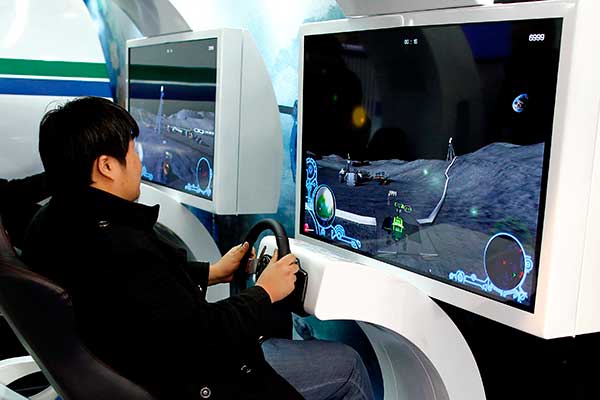
A visitor experiences a simulated lunar exploration program during the Beijing International Cultural and Creative Industry Expo in December.[Photo by Zhu Xingxin/China Daily]
It was midnight in mid-October, but Chen Min, who lives in a village near the Xichang Satellite Launch Center in Sichuan province, was still up and about. The vendor in her 20s was earning extra money by selling snacks to visitors who had arrived to watch a rocket launch.
“I make a living by farming, but whenever there is a space launch, I come here to make more money,” she said.
Chen and a few other villagers started selling snacks part time six years ago. They said the opportunities have come more frequently recently. “I’ve seen so many rocket launches that I’ve lost count of the total number,” she said.
The period of the 12th Five-Year Plan (2011-15) saw the highest number of missions in the history of China’s space exploration programs, according to the China Aerospace Science and Technology Corp, the main contractor for the programs, which said 78 space missions have been carried out since 2011.
“The number (of launches) exceeded the total in the previous decade (2001-10),” said a corporation spokesperson, who preferred not to be named.
More than 97 percent of the missions have been successful, the highest rate among members of the world’s elite space club, the spokesperson said.
Since 2011, those missions have sent 128 spacecraft from China and other countries into orbit, more than double the 60 launches between 2006 and 2010, according to the corporation.
“We have accomplished all the goals we set for the aerospace sector in the period 2011-15,” the spokesperson said.
In the last five years, efforts have been made to lay the groundwork for the assembly of space stations and to facilitate lunar exploration.
In a major breakthrough, China experimented with space rendezvous and docking technology, which is crucial for the assembly of space stations. Within two years of the launch of China’s first space lab, Tiangong 1, in 2011, three spacecraft-unmanned and manned-blasted off to test automatic and astronaut-controlled docking procedures with Tiangong 1. All the tests were completed successfully.
In 2013, the lunar exploration program completed a key step when the Chang’e 3 lunar probe was launched and soft-landed on the moon.
The country’s launch-vehicle family is also expanding via the development of several new rockets, including the Long March 5, a heavy-thrust carrier rocket designed to launch space station modules and a future lunar probe that will collect lunar soil samples. Two new types of launch vehicle, the Long March 6 and the Long March 11, which can be prepared for liftoff at short notice, debuted last month.
“In September alone, five rockets, including the Long March 6 and the Long March 11, sent 27 satellites into orbit, which is a testament to the capabilities of China’s space program,” said Jiang Jie, chief designer of the Long March 3A series of rockets.
The next five years will also see the maiden flights of the Long March 5 and the Long March 7, which will carry unmanned cargo spacecraft into orbit.
The rapid strides made by the rocket industry during the 12th Five-Year Plan are the result of China’s overall technological capability and government’s support, Jiang said.
In the coming five years, the country will perform experiments in life-support technology, a critical factor for the planned space station. The China Academy of Space Technology has said the country’s second space lab, called Tiangong 2, and a manned spacecraft will be launched next year, according to media reports.
Zhao Lei contributed to this story.
